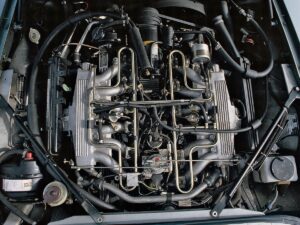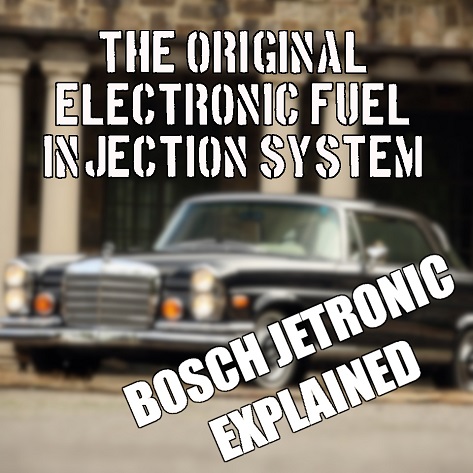Amidst the race to install the latest infotainment system in their cars, or the latest speaker systems from B&O, the world forgot just how complex cars really are. There are so many basic automotive functions that we take for granted these days — functions such as electronic fuel injection. Bosch Jetronic is one of the first systems to bring electronic fuel injection management to the consumer market, and today we’ll go back in time to take a closer look at this important piece of automotive engineering.

Bosch — Born From the Culture of Innovation
There is rarely a company that has contributed more to the progress of automotive industry than Bosch GmbH. Today, this brand represents one of the leading manufacturers of high quality OEM parts for various vehicles. More importantly, Bosch produces some of the most innovative and cutting edge engine management systems, as well as other complex electronic systems.
The culture of innovation from which this company was born goes back to its early days. Throughout his life, Robert Bosch, the founder of Bosch GmbH, was interested in achieving two goals — elegant new solutions to emerging engineering problems, and achieving uncompromising quality control.
It’s exactly these two core concepts that have allowed Bosch to design his original ignition system, which was miles ahead of anything the competition had to offer. With Robert long gone, the current leadership of Bosch GmbH hasn’t forgotten where their enterprise came from. The Bosch of today — an absolute giant of the industry — still holds Robert’s key principles at the core of its corporate mission.
When you purchase a Bosch part, you’re choosing a product that has been thoroughly tested. This company pushes their products way past its engineered failure points. In the end, you’re getting a reliable part that is a perfect fit.
The Story of Jetronic
The list of products that have made Bosch into a company that it is today, is massive. However, there are entries on that list that stand out because of their impact. That original ignition system Robert Bosch designed is a definitive turning point for the company. Yet, it wasn’t the only high-impact design that propelled the automotive industry a few steps along its evolutionary ladder.
Electronic Ignition Systems
There’s a lot to be said about carburetors and mechanical injection systems. They’re simple, robust, and often much more reliable than most people think. Carbs are a memento of times when the auto industry was all about raw performance. That being said, carbs are far from being the optimal solution for a modern car. Plus, carbs are overly romanticized these days.
Let’s put it this way — tuning 4 sets of 3-barreled Webber carbs on a ‘66 Miura is something many car enthusiasts dream of knowing how to do, and then actually doing it. On the other hand, tuning a simple carb on an ‘85 E30 isn’t anywhere near as fun nor dreamy. As cars evolved, carbs and mechanical injection systems became a serious bottleneck.
Can we credit Bosch with inventing the first electronic injection system? Not really. Electronic injection systems existed prior to Bosch taking interest, and were invented by the Bendix Corporation. However, when Bendix decided that they’ve had enough of their mercurial Electrojector system in the late ‘50s, Bosch saw an opportunity to get involved with this growing market segment.
Bendix eventually sold the license for Electrojector to Bosch, who promptly went on to make this rather unreliable system, reliable. Thus, the Bosch Jetronic (or D-Jetronic) was born.
D-Jetronic Explained
While perfecting the original Bendix Corp formula, Bosch went on to improve the overall design of the newly acquired product. The finished result, known back then as Bosch Jetronic, included a number of important components.
Depending on the vehicle you owned, you’d see a set of dampers, a network of fuel lines, fuel filters, a pressure adjuster, cabling, various pressure sensors (this is important), air temp sensors, engine temperature sensors, of course the injectors and the ECU.
Different cars had different configurations of Jetronic. Bosch Automotive had to adapt the system for each individual manufacturer who used this system in their cars, and there were many. From Lancia to Jaguar and Mercedes, the original Jetronic was a popular modern alternative to carbs in many markets.
How Does the Jetronic Work?

Compared to modern systems of its kind, Jetronic is relatively primitive. Despite being electronic in nature, this engine management system was almost completely analogue. Almost all the inputs used to give the Jetronic ECU an idea of what’s going on with the engine, were temperature and air pressure activated.
The principle behind this system is simple enough — the ECU tracks how much air is entering the intake manifold via the manifold pressure sensor, it adds that data to the position of the throttle, RPMs of the engine and temperature readings of several key locations on the engine. All of this data is then used to calculate the optima fuel trim solution for that particular situation.
Once the optimal trim is found, the ECU adjusts the pulse of each individual injector. That way, the engine achieves the best possible performance according to the data collected from all the system inputs.
Yet, despite the complex nature of this setup, the most important factor for the success of Jetronic was that legendary Bosch reliability. They took an innovative concept, reworked it until it achieved a high level of consistency, and then found a way to incorporate it reliably in a wide range of engines.
Benefits of Jetronic
The move from mechanical injection and carbs to electronic fuel injection was a matter of necessity. Carbs were a good, cheap solution, but far from the most efficient one. Your average carb was more than likely dealing with lag, and feeding an unstable mixture to the engine. The term unstable applies to even the slightest fluctuation in the mix, which can cause all kinds of issues to the engine.
Not to mention the fact that carbs were rigid by design. The way you set them up is exactly the way they’ll work up until they drop out of tune. This leads us to the first and the most obvious benefit of Bosch Jetronic — flexibility.
New Way of Engine Management
As we know now, electronic injection systems allow you to do so much more with the engine. The ECU can adjust the trim based on driving conditions, engine temperature, and a variety of other factors. Back when Jetronic was first appearing in serial production cars, the benefits were obvious right from the start. Manufacturers achieved better efficiency, lower fuel consumption and a more reliable combustion.

Of course, there’s also the question of ecology. Jetronic first appeared in the late ‘60s on select vehicles, a decade later and the auto industry began accepting the fact that pollution is a real issue. A more efficient engine is a cleaner engine in the eyes of those who worked on carbon emission laws and regulations.
D-Jetronic or Jetronic?
There’s a bit of an issue regarding the name Jetronic. Or, at least there used to be. If you know Bosch, you know that they rarely give new iterations of existing products a completely different name. Instead, they simply add a prefix to the existing name or alter it in some minor yet obvious way. The same happened with Jetronic.
Back when it first came out, Jetronic was the name used to market the system to various car manufacturers. However, as more and more versions of this electronic injection system came out (K-Jetronic, the entire LE-Jetronic and LU-Jetronic series), Bosch went back and changed the designation of the original setup to D-Jetronic where D stands for “Drucke”, or pressure in German.
Rest assured that these two names, with and without the D prefix, are both correct and both mark the exact same system. D-Jetronic is simply more accurate as it tells you which specific version you’re dealing with.
Still In Use Today
If you own a classic Mercedes, Volvo, BMW or even a Jaguar, there’s a chance that your car is running the old school Jetronic system. Servicing these systems requites a bit of effort and know-how that is scarce these days.
Most importantly, it requires genuine Bosch parts. Check our online store for one of the largest catalogs of Bosch products on this side of the pond. Simply enter your car’s year, make and model, and you’ll be presented with a list of products that matches your vehicle.



